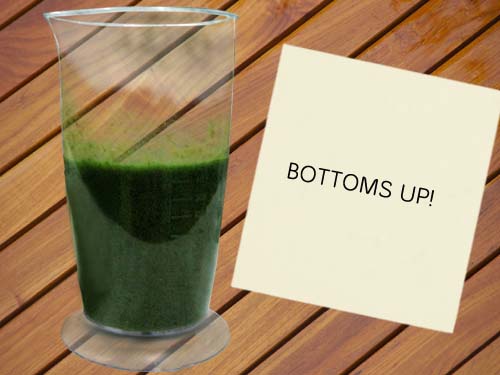Green smoothies from veggies and fruits
As a child, I grew up hearing my mom, a food and nutrition major, telling us kids to eat our green leafy vegetables so that we would grow up to be healthy. That meant the dark pechay in nilagang baka (boiled beef) or tinola (chicken stew), or the malunggay in the Friday staple dish, monggo (mung bean stew). To my child’s palate, these two greens had the most uninteresting and boring tastes, so I ate as little as I could get away with under our mom’s eagle eye. While my Ilocana mom did eat her green leafy vegetables, she also ingested a lot of animal fats (lechon), sodium (bagoong) and sugar (white rice). Today, she has type 2 diabetes, which is linked to lifestyle and is one of the fastest-growing diseases in the world. A diet rich in processed foods and the stress of modern life have created an environment in our bodies where diseases like diabetes, cancer, arthritis, osteoporosis, and various heart ailments can thrive. In an effort not to end up like my mom, I’ve begun to incorporate dark leafy greens and other super foods in my diet. Dark leafy greens and super foods Rapidly growing in popularity, super foods have high concentrations of disease-fighting nutrients. Apart from dark leafy greens, other super foods include nuts, tomatoes, salmon, eggs, beans, and low-fat or fat-free yogurt.  Dark leafy greens are a rich source of minerals (like iron, calcium, potassium and magnesium) and vitamins C, E, and many of the B vitamins. It also has vitamin K which regulates blood clotting, helps protect bones from osteoporosis, and may regulate inflammation and protect our bodies from arthritis as well as help prevent diabetes. Dark green leaves also provide a variety of phytochemicals such as beta-carotene, lutein and zeazanthin which protect our eyes and cells from damage, and small amounts of Omega-3 fatty acids. Leafy greens for breakfast In the sweltering summer heat, you can prepare a quick and cooling breakfast by blending a bunch of dark salad greens and fruits in a green smoothie that packs an abundance of healthy carbohydrates, vitamins, minerals, phytochemicals, chlorophyll and fiber in just one glass.
Dark leafy greens are a rich source of minerals (like iron, calcium, potassium and magnesium) and vitamins C, E, and many of the B vitamins. It also has vitamin K which regulates blood clotting, helps protect bones from osteoporosis, and may regulate inflammation and protect our bodies from arthritis as well as help prevent diabetes. Dark green leaves also provide a variety of phytochemicals such as beta-carotene, lutein and zeazanthin which protect our eyes and cells from damage, and small amounts of Omega-3 fatty acids. Leafy greens for breakfast In the sweltering summer heat, you can prepare a quick and cooling breakfast by blending a bunch of dark salad greens and fruits in a green smoothie that packs an abundance of healthy carbohydrates, vitamins, minerals, phytochemicals, chlorophyll and fiber in just one glass.  In a blender, place around 60 per cent of cut-up dark salad greens and 40 per cent of chopped fruits. Add enough water to blend the fruits and vegetables into a smoothie-like consistency. Add the juice of one calamansi or one-third of a lemon to flavor the smoothie and to prevent it from darkening too much. Apart from its flavor undertones in the smoothie, lemons are rich in phytonutrients with antioxidant and anti-cancer properties.
In a blender, place around 60 per cent of cut-up dark salad greens and 40 per cent of chopped fruits. Add enough water to blend the fruits and vegetables into a smoothie-like consistency. Add the juice of one calamansi or one-third of a lemon to flavor the smoothie and to prevent it from darkening too much. Apart from its flavor undertones in the smoothie, lemons are rich in phytonutrients with antioxidant and anti-cancer properties.  There’s no need to add any sweetener as the fruits will sweeten the concoction. As a general rule, using more ripe fruit (bananas, for instance) yields a sweeter smoothie.
There’s no need to add any sweetener as the fruits will sweeten the concoction. As a general rule, using more ripe fruit (bananas, for instance) yields a sweeter smoothie.  One bunch of Romaine lettuce leaves and three ripe bananas of the lakatan variety make a good pairing for those trying out green smoothies for the first time. This mix makes around four glasses of smoothies. Most Filipinos are familiar with iceberg lettuce, a variety of crisp-head lettuce which has curly light-green leaves used to hold potato or fruit salads in fancy restaurants. Iceberg lettuce, however, has hardly any nutritional value. In general, the darker the lettuce leaves and other green leafy vegetables, the more nutritious they are. Green ice lettuce or loose-leaf lettuce, the bunch with ruffled or crinkly leaves, or oak leaf lettuce are readily available in major supermarkets and weekend markets. But the leaves do not keep fresh and crisp for long and should be used as soon as possible. A better choice would be Romaine lettuce, which has eight times the vitamin A and six times the vitamin C as iceberg lettuce. Its leaves are darker and coarser than green ice lettuce or oak leaf lettuce and they keep longer. It is also readily available and reasonably priced. For P25, you can get one-fourth kilo of Romaine lettuce, around three or four bunches, which is enough for three batches of smoothies. Bananas are one of the best sources of potassium, which significantly lowers the risk of high blood pressure and related conditions like heart attacks and strokes. One serving of bananas can lower the risk of a stroke by 40 per cent and can also provide 30 per cent of daily values of vitamin B6. New studies indicate that bananas seem to act as a natural antacid. They contain electrolytes, which are needed to prevent dehydration, and folate for proper tissue growth and protection against cancer and heart disease. Green smoothie variations One powerful dark leafy green that could be the base for green smoothies is Popeye’s spinach. By itself one of the top super foods, spinach is an excellent source of vitamin C, folate, beta-carotene, vitamin E and manganese. It contains a compound of 13 flavonoids which work together to slow down a number of cancers. Spinach has been associated with improved brain function, improved eyesight, energy and improved gastrointestinal function. In smoothies, spinach can be used raw or slightly steamed. Apart from bananas, other fruits that can be used in green smoothies are papaya, apples, mangoes or pineapples. Papaya contains the digestive enzyme papain, which promotes heart health and protects against colon cancer. Apples contain several phytonutrients that act as antioxidants, which are found in the skins. Apples can significantly lower asthma risk and may also reduce the risk of certain cancers. Pineapples contain the enzyme bromelain, found in the stem and core of the pineapple, which can treat sports injuries, other trauma and allergies. Mangoes are rich in potassium and the antioxidants beta-carotene, quercetin and astragalin. However, they are high in natural sugar. You can mix and match any combination of greens and fruits, depending on your taste and the availability of ingredients. But for maximum health benefits, it would be best to keep the smoothie to the 60-40 ratio of greens and fruits. Bottoms up! - YA, GMANews.TV
One bunch of Romaine lettuce leaves and three ripe bananas of the lakatan variety make a good pairing for those trying out green smoothies for the first time. This mix makes around four glasses of smoothies. Most Filipinos are familiar with iceberg lettuce, a variety of crisp-head lettuce which has curly light-green leaves used to hold potato or fruit salads in fancy restaurants. Iceberg lettuce, however, has hardly any nutritional value. In general, the darker the lettuce leaves and other green leafy vegetables, the more nutritious they are. Green ice lettuce or loose-leaf lettuce, the bunch with ruffled or crinkly leaves, or oak leaf lettuce are readily available in major supermarkets and weekend markets. But the leaves do not keep fresh and crisp for long and should be used as soon as possible. A better choice would be Romaine lettuce, which has eight times the vitamin A and six times the vitamin C as iceberg lettuce. Its leaves are darker and coarser than green ice lettuce or oak leaf lettuce and they keep longer. It is also readily available and reasonably priced. For P25, you can get one-fourth kilo of Romaine lettuce, around three or four bunches, which is enough for three batches of smoothies. Bananas are one of the best sources of potassium, which significantly lowers the risk of high blood pressure and related conditions like heart attacks and strokes. One serving of bananas can lower the risk of a stroke by 40 per cent and can also provide 30 per cent of daily values of vitamin B6. New studies indicate that bananas seem to act as a natural antacid. They contain electrolytes, which are needed to prevent dehydration, and folate for proper tissue growth and protection against cancer and heart disease. Green smoothie variations One powerful dark leafy green that could be the base for green smoothies is Popeye’s spinach. By itself one of the top super foods, spinach is an excellent source of vitamin C, folate, beta-carotene, vitamin E and manganese. It contains a compound of 13 flavonoids which work together to slow down a number of cancers. Spinach has been associated with improved brain function, improved eyesight, energy and improved gastrointestinal function. In smoothies, spinach can be used raw or slightly steamed. Apart from bananas, other fruits that can be used in green smoothies are papaya, apples, mangoes or pineapples. Papaya contains the digestive enzyme papain, which promotes heart health and protects against colon cancer. Apples contain several phytonutrients that act as antioxidants, which are found in the skins. Apples can significantly lower asthma risk and may also reduce the risk of certain cancers. Pineapples contain the enzyme bromelain, found in the stem and core of the pineapple, which can treat sports injuries, other trauma and allergies. Mangoes are rich in potassium and the antioxidants beta-carotene, quercetin and astragalin. However, they are high in natural sugar. You can mix and match any combination of greens and fruits, depending on your taste and the availability of ingredients. But for maximum health benefits, it would be best to keep the smoothie to the 60-40 ratio of greens and fruits. Bottoms up! - YA, GMANews.TV





